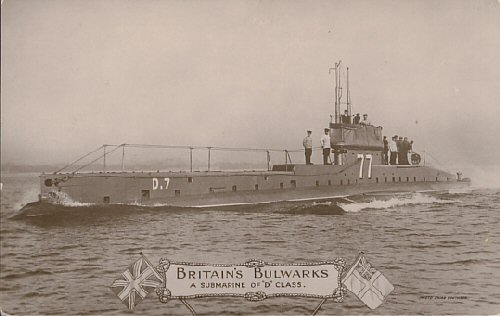
Paid off July 1919
The D Class was the Admiralty's first attempt to produce a submarine that could carry out extended patrols away from coastal areas.
They had increased displacement, greater internal space and most importantly, diesel engines driving through twin propellers. They were also the first boats to be fitted with wireless transmitters.
The innovative use of saddle tanks to hold the main ballast water externally provided additional inboard space, although the larger engines, and an additional torpedo tube aft and enlarged compliment, probably left little for improved habitability. With their enlarged bridge structure, these boats had a profile that became that of the conventional submarine. The D Class submarines were considered to be so innovative, that D1 was built in the utmost secrecy in a securely guarded building shed. Launched with equal secrecy, with only departmental heads and a few officers from the cruiser H.M.S. Mercury (3,730 tons), that was currently in Barrow being present. Once moved to the fitting out berth, she was once again screened from inquisitive eyes.
A successful and relatively reliable class of submarine, the D class worked very hard during WWI, patrolling the North Sea and the Heligoland Bight, and protecting the cross channel troopships.
During the war, four boats D2, D3, D5, and D6 were lost, whilst D4, D7, and D8 were Paid Off in July 1919.
D7 was almost sunk in error by HMS Pelican on 10 February 1918.